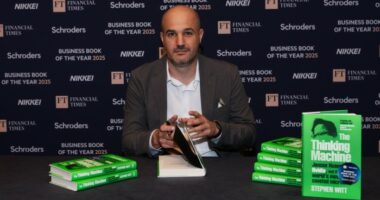Share this @internewscast.com
For the first time this year, I decided to take a closer look at the performance of my stocks and shares ISA, along with my personal pension.
Typically, I prefer to give my investments the space they need to mature, focusing on their long-term potential for generating income and capital growth. I’m not one to frequently intervene.
This unusual review of my investments—by the way, they’re doing reasonably well—was prompted by the current volatility in global stock markets and the looming fears of a potential crash.
The market’s fluctuations on Friday only heightened these worries.
I’m not alone in this concern. Many friends and colleagues are also re-evaluating their portfolios, including the junior ISAs set up for their children. They’re considering whether adjustments are necessary in anticipation of a possible market downturn. Some are even pondering drastic measures, such as selling all their assets and waiting to reinvest once share prices have dropped post-crash.
On one hand, this strategy seems quite logical. On the other, it could prove costly if the anticipated crash doesn’t happen.
Some with pension funds and who are close to retirement have already turned investments into cash, not wishing to risk their financial future. I get that.
Others are thinking of a portfolio reboot – taking profits from investments that have made them handsome returns and employing the cash generated to diversify their fund, asset and geographic exposure. Diversification to the power three.

I’m not alone. Friends and colleagues have been scrutinising their portfolios to see whether they need to make changes ahead of a likely market correction, writes Jeff Prestridge
The final group comprises those happy to brazen things out. They’re content to adopt a long-term strategy in the belief that shares represent the best way to accumulate the wealth needed to help them finance a comfortable life in retirement.
Market corrections are part and parcel of investing, and nobody knows which strategy will prove to be best.
Selling ahead of the bursting of the tech bubble in early 2000, and then reinvesting shortly afterwards, proved a shrewd move, although few did. The fear of missing out (FOMO) got in the way.
Many investors in tech Isas – which were all the rage at the time – suffered horribly as a result, with some put off investing for life as their plans were washed away.
More recently, the 2020 market correction, triggered by Covid and lockdown, was painful but short and sweet. Those who hung on to their investments were back in profit by the end of 2021 and have gone on to enjoy some outstanding returns.
This time around, however, the market correction could be more painful and on a par with the bursting of the dotcom bubble at the start of the millennium.
Like 25 years ago, tech is the lighter fuel of the current bubble, and again it’s centred in the United States. Over enthusiasm for the ‘magnificent seven’ stocks (Google-owner Alphabet, Amazon, Apple, Meta, Microsoft, Nvidia and Tesla), fuelled by the artificial intelligence (AI) revolution, has driven many US stocks to unfathomable heights – leaving some seriously overvalued.
But a smidgeon of bad news – one of the magnificent seven posting poor results, or further trade or geopolitical friction between China and the US – could see investors running for the hills, puncturing the bubble and sending share prices down.
While Nvidia sits at the heart of the AI revolution, I’m not sure that the value which the market puts on it ($3.3 trillion) is sustainable. Over the past five years, Nvidia’s shares have risen by an extraordinary 1,220 per cent.
Likewise, shares in Palantir Technologies – another AI player – have gone into stratospheric territory, climbing 1,780 per cent.
The equivalent increase in Broadcom’s shares (850 per cent) looks modest by comparison (its technology is key to the building of large-scale AI networks).
Those share prices – along with others – are set for a fall as sure as night follows day. And there are many financial experts who fear we are heading for a market crash. They include the bosses of some mighty institutions – the Bank of England and the International Monetary Fund.
A number of investment houses are also nervous, as evidenced by the latest survey from Bank of America. It shows that a third of fund managers now believe an AI bubble represents the biggest risk to stock markets (and, by implication, to investors). The fact this figure has tripled in a month is scary.

The 2020 market correction, triggered by the Pandemic, was painful but short and sweet. Those who hung on to their investments were back in profit by the end of 2021
So what do we do? As indicated by my recent interactions with friends and colleagues, we’re not all the same. Some are risk takers, others more cautious.
Age is key, with risk aversion tending to play a greater part in our investment decision-making as we get older. Risk aversion is also a big factor when we’re starting a family or buying a first home.
Other financial arrangements can influence our propensity to take investment risk, too.
The prospect of a secure works pension or a sizeable pension pot can give us the scope to be more relaxed about our investing – as can ownership of other assets such as an income-producing buy-to-let property.
So do what is best for you and, if in doubt, speak to an investment adviser whose profession is to design portfolios for clients based on meeting their long-term financial needs.
My strategy remains the same as it was in those scary days of 2020 when it seemed the world was coming to an end. I will keep invested with both my Isa and pension diversified across funds and trusts, investment managers, assets and stock markets.
They will be magnificent seven and AI light.
It’s an approach many experts and investors are respectively preaching and taking.
‘Artificial intelligence has created pockets of froth, concentration risk and current valuations are pricing in huge optimism about growth ahead,’ warns Jason Hollands of wealth manager Evelyn Partners. ‘Diversification is your best defence – into UK equities, Europe and emerging markets.’
As for investors, wealth platform AJ Bell reports a marked increase in purchases of global funds that exclude US assets – the likes of exchange-traded fund Xtrackers MSCI World Ex-USA.
Other US funds that downplay the magnificent seven include S&P 500 Equal Weight, Dodge & Cox Worldwide US Stock and FTSE RAFI US 1000.
SAVE MONEY, MAKE MONEY
Sipp cashback

Sipp cashback
£200 when you deposit or transfer £15,000
4.51% cash Isa
4.51% cash Isa
Trading 212: 0.66% fixed 12-month bonus
£20 off motoring

£20 off motoring
This is Money Motoring Club voucher
Free shares bundle

Free shares bundle
Get free UK shares worth up to £200
4.37% Isa with bonus

4.37% Isa with bonus
Now with no penalty for withdrawals
Affiliate links: If you take out a product This is Money may earn a commission. These deals are chosen by our editorial team, as we think they are worth highlighting. This does not affect our editorial independence. Terms and conditions apply on all offers.













